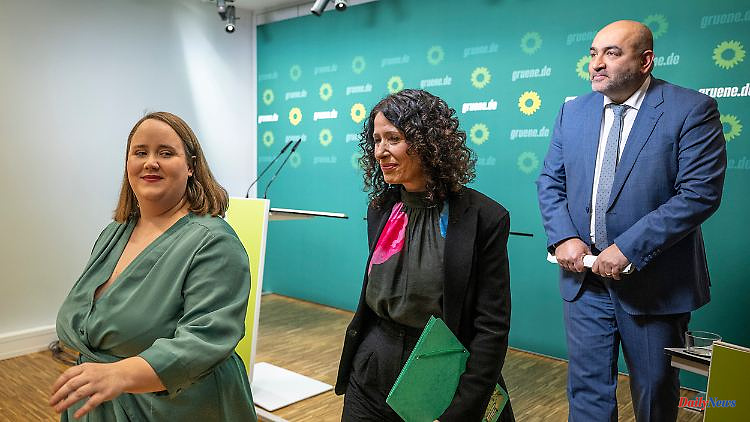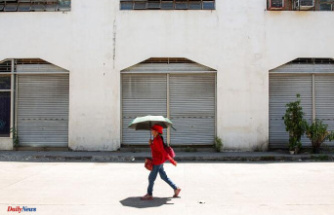The Greens are unlikely to be the next governing mayor. Nevertheless, their election result, level with the SPD, is a minor sensation. Because whether in the federal states or the federal government: Unlike their respective coalition partners, the Greens are not punished for governing.
Sometimes it's the little things in life. 0.5 is such a small number. The Greens lost so few percentage points after second votes in the repeat of the Berlin House of Representatives election. And that despite the fact that around 70 percent of Berliners were dissatisfied with the work of the red-green-red Senate. But it was mainly the SPD and the Left Party who received the receipts for this. Another small figure is 17 percent: so few Berliners would want to vote for the Greens' top candidate Bettina Jarasch if they could directly appoint the governing mayor.
Before the re-election, there were some arguments against the Greens being successful in the elections. Nevertheless, they were almost able to repeat their record election result from 2021 and are almost on a par with the SPD this time. Note: Governing in the capital did not harm the Greens. That doesn't change the fact that, coming in third just behind the SPD, they have no prospects of leading the government in a green-red-red alliance - 105 votes difference or not.
The 2023 Berlin election confirms a development that has been observed for some time. In the federal trend, too, approval of the party is consistently high. Even if they recently fell behind the SPD again in the RTL/ntv trend barometer, the Greens have reliably received more approval since they joined the traffic light coalition than in the last federal election. The 14.8 percent at that time was a record result for the now 41-year-old party. The FDP and SPD can only dream of this. The FDP in particular only caught itself in all the past five state elections and missed entering parliament three times. For the Greens, only the election result in Saarland was disappointing, but the state association there is a special case.
The high level of popularity would be less surprising if the Greens were also celebrating one success after another politically. But in fact the party had to swallow a lot, especially in the federal government: from the rejection of the speed limit in the coalition agreement to the extension of the service life for coal and nuclear power plants to the protests in Lützerath. None of this has shaken the good poll numbers of the Greens. The party base does not rumble either. No other party in Germany governs as blissfully as that of the former knit sweater revolutionaries and Castor opponents. The third generation of the Green party leadership has very little in common with them.
In recent years, the Greens have not only grown to be on par with the SPD, they have also consolidated their electoral base. The election result map of Berlin shows who these voters typically are: within the so-called ring, the inner city surrounded by the S-Bahn, the map is green. Outside it is black. By far not only very high earners live in the city, as some believe the Green voters. But in Kreuzberg-Friedrichshain and in parts of Neukölln, Schöneberg-Tempelhof and Prenzlauer Berg, a young urban milieu is at home: relatively young, well educated, often academic, often with children and just as often without their own car. This clientele, which can now be found in every small and large town across Germany, obviously has stable party ties. Almost like the SPD once had among workers or the FDP among craftsmen.
For the Greens, this is definitely cause for celebration: it is possible to build on a stable electoral base. But the question of how is just as unanswered under the chairmen Ricarda Lang and Omid Nouripour as with their predecessors Annalena Baerbock and Robert Habeck. The party remains weak in the countryside (or Berlin-Spandau), in the east anyway and especially among low-income earners who, despite the party's socio-political profile, have little hope of the Greens. And it doesn't reach the elderly. According to Infratest Dimap, the Greens in Berlin were the strongest among the under-60s with 24 percent. Among those over 60, just 9 percent voted for the Jarasch party.
Many of the homeowners who commute by car every day, whether they live on the outskirts of Berlin or in a village far from a metropolis, feel largely misunderstood by the Verkehrswende party. Seen in this way, the excitement about the blocking of the Berlin promenade Friedrichstrasse for cars and the Greens' suggestion to halve the number of parking spaces in the capital was exemplary: The outcry of a large section of the population was great, but the Greens' clientele did not challenge it. And unlike the core clientele of some other parties, the green-urban academics vote comparatively reliably. In particular, Germany's former metropolitan party SPD, which after two decades may have lost its governing role in Berlin, this development will cause headaches for some time to come.












